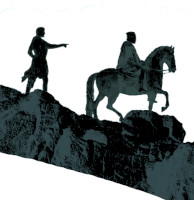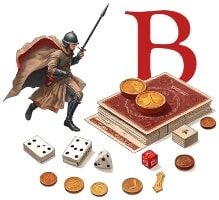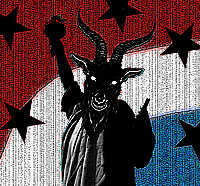Book 5 of Metamorphoses continues with the slaughter of the Ethiopian Nobility by Perseus, his crime of success outweighing his heroics coming to their aid. The graphic slaughter is right out of the Iliad and depicts tribal warfare of earlier ages and ancestral people. Though the weapons may have been similar iron, muscle-powered tools to Ovid’s time, their use in Ovid’s work is taken from pre-civilized tradition and does not reflect the combat of Ovid’s time—either in the Gladiatorial Arena or in military combat—any more closely than the actions of the American Revolution and WWII.
The second half of Book 5 and all of Book 6 consists of origin stories of gods and birds. These are almost all from the feminine perspective and are told to Pallas Athena or Minerva by various nymphs. Nymphs are the key perspective creatures of Ovid thus far. The rape of Persephone by Hades/Pluto/Dys and her being taken into the underworld to be the eternal death bride of the Lord of The Third Part of the World [1] may hint at this tale as one of the Bronze Age Collapse, when grain agriculture was largely destroyed and migration by ship and by cattle droving became an Iron Age Lifeway.
The mother of Persephone, sister and wife to Jove, Ceres, the grain mother, travels in a chariot drawn by two dragons in search of her daughter across, heaven, earth and hell, being the three worlds. She eventually strikes a bargain through Jove, brother of Pluto, that she may have Persephone [fertility] for half the year and that for the other half of the year, Persephone will languish as a death bride in the underworld. Of interest, is the fact that Jove may not call Persephone back into heaven because she has been observed eating of the fruit of a purple pomagranate in the shade garden of Dys.
The nymphs recount over a dozen cases of Jove, Pluto, Neptune, Apollo and Boreos raping nymphs or mortal women and fathering heroes. Dryads, nymphs, fauns and other “native gods” and supernatural earthly attendants of heavenly goddesses dominate Book 6.
“Nature has not made the sun or running water for common use, not to be the property of one,” says one wayfaring goddess who is ill-treated by profane peasants. The mistreatment of deities by men, and the hubris of certain arrogant kings and ladies, are routinely punished by the offended gods cursing them to eternal life as lizards, stags, fish, statues, stones, frogs—Arachne the weaver into a spider—but most commonly into birds, such as a screech owl, and of magpies originating as gossiping wenches. The murdering king of Scythia, Lyncus, was turned into the Lynx as punishment for trying to murder a visitor.
Pelops, “Red-face” was cut to pieces by his father but was then re-assembled like a bionic automaton. The southern half of Greece separated by the Isthmus of Corinth was named after him as Red-face-island.
Of precise interest as a post cataclysmic event, is Ovid’s relation of Ceres. Beyond Hamilton’s excellent treatment of the myth as an explanation of the origin of seasons and fertility, is the story of Sicily. Sicily, which great weight kept hundred-headed Typhon buried under Mount Etna in Tartarus and was known as the most fertile crop land, was described as having suffered famine directly as the result of Ceres’ wrath over Persephone being abducted near there. This act, along with the numerous stories of Juno, mother of the gods, and her daughter Minerva brutally punishing earthly women for lack of humility of simply for their beauty, dominate Books 5 and 6. Sicily was the source of certain tribes of The Sea Peoples who ravaged the Bronze Age Civilizations, the fall of which might have served as sources for some of these accounts.
The most fascinating thing about books 4 thru 6 is the persistent and even childish legends of humans being turned into other creatures as origin stories for those creatures, with an obsession with intelligent winged creatures and also of super intelligent winged gods. Listening to the accounts of Athena, Apollo and Artimus flying through the middle sky killing and transforming humans, and particularly of the latter two shooting human warriors from on high and afar without even being seen, evokes images of modern American might. P-52s annihilating German tanks that never saw them, B-17s firebombing Japanese cities in the dark, helicopter gunships blasting rice farmers in Vietnam [2], of helicopter borne Americans describing operations against Muslim resistance groups based on the ground in Iraq and Afghanistan as “big game hunting,” [3] all of these images are scarcely distinguishable, from the victim’s perspective, from Apollo punishing hapless humans from the sky.
There is an intense relationship between the sons and daughters of Athena [Thought, the most wrathful deity, to include War] and the northern barbarians of blond hair, the Thracians and Scythians. Do note that the Athenians had blond hair too, such as Perseus. Two sisters of Athens become winged beings once a Thracian king marries one and abducts and cuts the tongue from the other and then they retaliate by killing his son and feeding the boy to the father. The king too, is transformed into a bird species. Likewise, the winged deity, Boreos, who controls the north winds, is a winged creature that abducts another daughter of Athens and fathers a hybrid race on her, with the winged twins that accompany Jason his sons.
A feminized society based on thought and committed to wrathful righting of wrongs that came into being in close association with unilateral air supremacy, might this be a legendary echo of some fallen empire that had a means of air travel. Considering that humans currently lack the capacity to duplicate the Pyramids and other pre-historic monuments in Peru, yet have possessed the power of military flight for over 100 years, is it that impossible?
The flying and descending powers of heaven and hell and the flying and ascending heroes, nymphs and raped princesses of earth, may just be legends for the origins of various birds to entertain children. But their expression in Ovid is deeply serious, pious and executed in the belief that such things happened and such winged powers existed. The most widespread current religious beliefs, being in Christ, from Ovid’s period, is based on the belief of Jesus ascending to heaven and that he will return from heaven. As I listen to a jet airliner shuttling petty currency-farmers out of PDX airport towards the east, the standard doctrine that all human progress is lineal and not cyclic and that no prehistoric race might have invented balloon travel, seems as childish as Ovid’s tale of the Hooping Bird.
Notes
-1. Jove won heaven at dice, Pluto losing and getting hell, and Neptune the oceans, these being the three masculine worlds that surrounded the feminine sphere of Earth.
-2. See the Vietnam memoir Firebird.
-3. From a personal interview.











